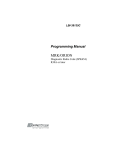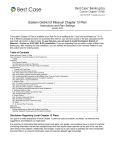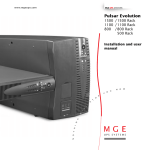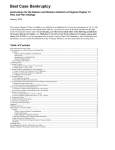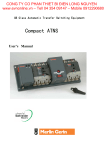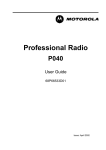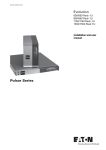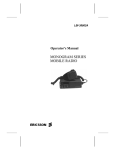Download Comnet LBI-31693B Operator`s manual
Transcript
LBI-31693B Operator’s Manual MLS II Mobile Radio This manual is published by Com-Net Ericsson Critical Radio Systems, Inc., without any warranty. Improvements and changes to this manual necessitated by typographical errors, inaccuracies of current information, or improvements to programs and/or equipment, may be made by Com-Net Ericsson Critical Radio Systems, Inc., at any time and without notice. Such changes will be incorporated into new editions of this manual. No part of this manual may be reproduced or transmitted in any form or by any means, electronic or mechanical, including photocopying and recording, for any purpose, without the express written permission of Com-Net Ericsson Critical Radio Systems, Inc. Copyright © 1986-2000 Com-Net Ericsson Critical Radio Systems, Inc. All rights reserved. 2 TABLE OF CONTENTS SAFETY INFORMATION ..........................................................4 SAFE DRIVING RECOMMENDATIONS FOR USERS OF MOBILE RADIOS RECOMMENDED BY AAA ...............................................5 OPERATING RULES AND REGULATIONS.............................5 OPERATING STANDARD (TWO CHANNEL) RADIO ..............7 CONTROLS AND INDICATORS.....................................................8 CONTROLS ..............................................................................8 INDICATORS ............................................................................8 USING THE RADIO.........................................................................9 TO RECEIVE A MESSAGE ......................................................9 TO TRANSMIT A MESSAGE ...................................................9 OPERATING THE OPTIONAL 8 OR 16 CHANNEL RADIO ... 10 CONTROLS AND INDICATORS...................................................11 CONTROLS ............................................................................11 INDICATORS ..........................................................................12 USING THE OPTIONAL 8 OR 16 CHANNEL RADIO (WITHOUT SCAN)............................................................................................13 TO RECEIVE A MESSAGE ....................................................13 TO TRANSMlT A MESSAGE..................................................13 SCAN OPERATION ................................................................ 14 RECEIVE SCAN RATE...........................................................14 TRANSMIT IN SCAN MODE ..................................................15 TO PROGRAM SCAN CHANNELS AND SELECT PRIORITY.....15 USING THE OPTIONAL 8 OR 16 CHANNEL RADIO (WITH SCAN)............................................................................................17 SCAN MODE ..........................................................................17 3 SAFETY INFORMATION The operator of any mobile radio should be aware of certain hazards common to the operation of vehicular radio transmissions. A list of several possible hazards is given: 1. Explosive Atmospheres - Just as it is dangerous to fuel a vehicle with the motor running, similar hazards exist when operating a mobile radio. Be sure to turn the radio off while fueling a vehicle. Do not carry containers of fuel in the trunk of a vehicle if the radio is mounted in the trunk 2. Interference to Vehicular Electronics Systems - Electronic fuel injection systems, electronic anti-skid braking systems, electronic cruise control systems, etc., are typical electronic systems that may malfunction due to the lack of protection from radio frequency energy present when transmitting. If the vehicle contains such equipment, consult the dealer and enlist their aid in determining the expected performance of electronic circuits when the radio is transmitting. 3. Dynamite Blasting Caps - Dynamite blasting caps may be caused to explode by operating a radio within 500 feet of the blasting caps. Always obey the "Turn Off Two-Way Radios" signs posted where dynamite is being used. When transporting blasting caps in your vehicle: • • Carry the blasting caps in a closed metal box with a soft lining. Leave the radio OFF whenever the blasting caps are being put into or removed from the vehicle. 4. Radio Frequency Energy - To prevent burns or related physical injury from radio frequency energy, do not operate the transmitter when anyone outside of the vehicle is within two feet of the antenna. 5. Liquefied Petroleum (LP) Gas Powered Vehicles - Mobile radio installations in vehicles powered by liquefied petroleum gas with the LP gas container in the trunk or other sealed-off space within the interior of the vehicle must conform to the National Fire Protection Association standard (NFPA) 58 requiring: • 4 The space containing the radio equipment shall be isolated by a seal from the space containing the LP gas container and its fittings. • Outside filling connections shall be used for the LP gas container. • The LP gas container shall be vented to the outside of the vehicle. SAFE DRIVING RECOMMENDATIONS FOR USERS OF MOBILE RADIOS RECOMMENDED BY AAA ∗ Read the literature on the safe operation of the radio. ∗ Keep both hands on the steering wheel and the microphone in its hanger whenever the vehicle is in motion. ∗ Place calls only when vehicle is stopped. ∗ When talking from a moving vehicle is unavoidable, drive in the slower lane. Keep conversations brief. ∗ If a conversation requires taking notes or complex thought, stop the vehicle in a safe place and continue the call. ∗ Whenever using a mobile radio exercise caution. OPERATING RULES AND REGULATIONS Two-way FM radio systems must be operated in accordance with the rules and regulations of the local, regional, or national government. In the United States, the radio must be operated in accordance with the rules and regulations of the Federal Communications Commission (FCC). As an operator of two-way radio equipment, you must be thoroughly familiar with the rules that apply to your particular type of radio operation. Following these rules helps eliminate confusion, assures the most efficient use of the existing radio channels, and results in a smoothly functioning radio network. When using your two-way radio, remember these rules: 1. It is a violation of FCC rules to interrupt any distress or emergency message. As your radio operates in much the same way as a telephone "party line", always listen to make sure that the channel is clear before transmitting. Emergency calls have priority over all other messages. If someone is sending an emergency message - such as reporting a fire or asking for help in an accident - KEEP OFF THE AIR! 2. The use of profane or obscene language is prohibited by Federal law. 3. It is against the law to send false call letters or false distress or emergency messages. The FCC requires that you keep conversations brief and confine them to business. To save time, use coded messages whenever possible. 5 4. Using your radio to send personal messages (except in an emergency) is a violation of FCC rules. You may send only those messages that are essential for the operation of your business. 5. It is against Federal law to repeat or otherwise make known anything you overhear on your radio. Conversations between others sharing your channel must be regarded as confidential. 6. The FCC requires that you identify yourself at certain specific times by means of your call letters. Refer to the rules that apply to your particular type of operation for the proper procedure. 7. No changes or adjustments shall be made to the equipment except by an authorized or certified electronic technician. IMPORTANT Under U.S. law, operation of an unlicensed radio transmitter within the jurisdiction of the United States may be punishable by a fine of up to $10,000, imprisonment for up to two years, or both. WARNING The 406 to 406.1 MHz frequency Band is reserved for use by distress beacons. 6 OPERATING STANDARD (TWO CHANNEL) RADIO STANDARD 2-CHANNEL RADIO 7 CONTROLS AND INDICATORS CONTROLS POWER A momentary type switch to turn the radio on or off. Press once to turn the radio on; press again to turn the radio off. Power ON is indicated by an illuminated channel number on the system module. VOLUME Momentary type switches to adjust the volume. Press and hold the MAX (up arrow) to increase the volume. Press and hold the MIN (down arrow) to decrease the volume. CHANNEL Two push type switches. Press CHAN 1 (up arrow) to select channel 1; press CHAN 2 (down arrow) to select channel 2. The selected channel number will be illuminated on the control module. A momentary type switch to allow you to monitor the selected channel before transmitting a message. It disables channel guard and squelch and will allow you to hear noise if the channel is not busy. This may be convenient when setting the volume to the desired level. MONITOR INDICATORS XMIT (transmit) Lights when your message is being transmitted. BUSY Lights when the channel is in use. CHANNEL Lights to indicate which channel has been selected 8 USING THE RADIO TO RECEIVE A MESSAGE 1. Turn the radio on (channel indicator lit). If not, press POWER switch. 2. Select the desired channel by pressing either the 1 or 2 switch. 3. Press and hold MONITOR switch and then adjust VOLUME controls for the desired listening level. Release MONITOR switch. 4. Radio is now ready to receive a message. TO TRANSMIT A MESSAGE 1. Confirm that the radio is turned on (channel indicator lit). If not, press POWER switch. 2. Select the desired channel by pressing either the 1 or 2 switch. 3. Press and hold MONITOR switch and then adjust VOLUME controls for the desired listening level. Release MONITOR switch. 4. Decide what you want to say. If you intend a lengthy message (or several messages), the vehicle engine should be running to maintain the battery charge. 5. Observe the BUSY indicator and press the MONITOR switch to assure that the channel is not in use. 6. Remove microphone from hookswitch, press the PTT switch, and identify yourself. The XMIT indicator will light each time the PTT switch is pressed. 7. Release the PTT switch and wait for an answer to your call, then complete your message. NOTE: Always speak in a normal voice. Hold the microphone cupped in your hand and touching your cheek lightly. Speak across the face of your microphone, not directly into if. Shouting will actually reduce your radio range, so do not speak any louder than normal. 9 OPERATING THE OPTIONAL 8 OR 16 CHANNEL RADIO 8 CHANNEL RADIO WITHOUT SCAN/WITH SCAN 16 CHANNEL RADIO WITHOUT SCAN/WITH SCAN 10 CONTROLS AND INDICATORS CONTROLS POWER A momentary type switch to turn the radio on or off. Press once to turn the radio on; press again to turn the radio off. Power ON is indicated by an illuminated channel number on the system module. VOLUME Momentary type switches to adjust the volume. Press and hold the MAX (up arrow) to increase the volume. Press and hold the MIN (down arrow) to decrease the volume. MONITOR A momentary type switch to allow you to monitor the selected channel before transmitting a message. It disables channel guard and squelch and will allow you to hear noise if the channel is not busy. This may be convenient when setting the volume to the desired level. CHANNEL Two momentary type switches to select channels electronically. Press and hold the ADD switch to increase the channel number; press and hold the DELETE switch to decrease the channel number. The selected channel is displayed by the 7-segment display. ADD When used in conjunction with the SCAN switch, adds channels from the SCAN list. DELETE When used in conjunction with the SCAN switch, deletes channels from the SCAN list. SCAN A momentary type switch to turn the scan function on or off. When used in conjunction with the CHANNEL switch it enables the ADD/DELETE function to allow the scan list to be modified. When turned on, the scan indicator is illuminated. 11 INDICATORS XMIT (transmit) Lights when your message is being transmitted. BUSY Lights when the channel is in use. CHANNEL Lights to indicate which channel has been selected. P1 When lit, indicates that the channel displayed is a Priority 1 scan channel. P2 When lit, indicates that the channel displayed is a Priority 2 scan channel. S When lit, indicates that the channel displayed is a non-priority scan channel. SCAN When lit, indicates that the radio is operating in the scan mode. The channel indicator displays the following conditions: 12 • When scan is off the selected channel is shown. • When scan is on, the last pre-scan selected channel is shown when no signal is being received. When a scan channel is being received and audio is present in the speaker, the receive channel is shown. USING THE OPTIONAL 8 OR 16 CHANNEL RADIO (WITHOUT SCAN) TO RECEIVE A MESSAGE 1. Turn the radio on (channel indicator lit). If not, press POWER switch. 2. Select the desired channel by pressing either the ADD or DELETE switch. 3. Press and hold MONITOR switch and then adjust VOLUME control for the desired listening level. Release MONITOR switch. 4. Radio is now ready to receive a message. TO TRANSMlT A MESSAGE 1. Confirm that the radio is turned on (channel indicator lit). If not, press POWER switch. 2. Select the desired channel by pressing either the ADD or DELETE switch. 3. Press and hold MONITOR switch and then adjust VOLUME controls for the desired listening level. Release MONITOR switch. 4. Decide what you want to say. If you intend a lengthy message (or several messages), the vehicle engine should be running to maintain the battery charge. 5. Observe the BUSY indicator and press the MONITOR switch to assure that the channel is not in use. 6. Remove microphone from hookswitch, press the PTT switch, and identify yourself. The XMIT indicator will light each time the PTT switch is pressed. 7. Release the PTT switch and wait for an answer to your call. Then, complete your message. NOTE: Always speak in a normal voice. Hold the microphone cupped in your hand and touching your cheek lightly. Speak across the face of the microphone, not directly into it. Shouting will actually reduce your radio range, speak not speak any louder than normal. 13 SCAN OPERATION The SCAN function allows monitoring of up to 8 or 16 receive channels (depending upon which control module is being used). The scanned channels may be any frequency within the frequency band limits of the radio and may be Channel Guard protected. The radio messages will then be received only if the correct Channel Guard signal is present. Any channel may be scanned with or without priority level. One channel may be programmed for Priority 1 (P1) and another for Priority 2 (P2) with any or all remaining programmed channels being scanned as non-priority. RECEIVE SCAN RATE The scan rate for the radio will vary depending upon the number of channels programmed into the scan memory and whether or not Channel Guard is programmed. For a 16 channel radio the scan rate will vary from 1.1 to 4.4 seconds for non-priority channels and 0.3 to 1.2 seconds for Priority 1 and 2 channels. The scan rate will be faster when fewer channels are programmed into scan memory. Scan operation will be determined by the following conditions: • Priority 1, Priority 2, and Non-Priority Programmed* The Priority 1, Priority 2, and up to six remaining channels in an 8 channel radio or 14 channels in a 16 channel radio will be scanned. Once a carrier is detected (or correct Channel Guard tone is decoded), the digital display will indicate the Channel. Sampling of the Priority 1 and Priority 2 channels continues while receiving a message on a non-priority channel. Should a Priority 1 or 2 channel carrier (and correct Channel Guard) be detected while a non-priority channel is being received, the applicable indicator, P1 or P2, lights and the channel is switched to the Priority 1 or 2 channel regardless of what is being received on the non-priority channel. If a Priority 2 channel is detected, sampling of the Priority 1 channel continues. Once a carrier (and correct Channel Guard) is detected on the Priority 1 channel, the channel is switched to the Priority 1 channel regardless of what is being received on another channel (Non-priority or Priority 2). No sampling occurs during transmit or if a Priority 1 channel is receiving. • 14 Non-Priority Programmed Up to 8/16 non-priority channels may be scanned. Once a carrier is detected (or correct Channel Guard tone is decoded) the digital display will indicate the channel. Scan will stop and remain on the channel until the carrier disappears; after a few seconds scanning resumes. The channels will be scanned in descending order. * The rate the P1 and P2 channels are sampled while listening to a nonpriority channel depends whether RF carrier is present or not. If no carrier is present on P1 or P2, the scan rate is fast. If carrier is detected but incorrect Channel Guard is present, the rate slows considerably. This prevents the non-priority signal from being badly distorted by the larger mute times needed to detect Channel Guard. If Channel Guard is not programmed for P1 or P2 the scan rate remains fast. TRANSMIT IN SCAN MODE Several characteristics in the transmit mode occur if the radio has been placed in the scan mode of operation. ∗ Radio is in scan mode but there is no carrier activity to stop the scan on any channel. Removing the microphone from its hookswitch will stop the scanning activity and the radio will revert to the pre-scan selected channel. Replacing the microphone will enable the scan mode after a few seconds delay. ∗ Radio is in scan mode and carrier activity on a channel has caused scan to stop. Removing the microphone from its hookswitch will keep that channel selected. When push-to-talk (PTT) is pressed on the microphone, the transmit channel will be the displayed channel. The channel can be changed during this time as needed but will be forgotten when scanning resumes. Placing the microphone back on the hookswitch will cause scan to resume, after a few seconds delay. ∗ The Channel Guard decode is disabled whenever the microphone is removed from its hookswitch. ∗ During the scan mode the MONITOR and CHANNEL selection functions are disabled if scan is not stopped on a channel. TO PROGRAM SCAN CHANNELS AND SELECT PRIORITY The selection of scan channels and priority is front panel programmable using the SCAN switch in conjunction with the ADD and DELETE switch. NON-PRIORITY(S) 1. Confirm that radio is turned on (channel number is lit). If not, press the POWER switch. 2. If SCAN indicator is lit, press and release the SCAN switch to disable scan function. 3. Select desired channel using the ADD or DELETE switch. 4. Press and hold SCAN switch, then press the ADD switch once to add the 15 channel to the scan list. The S indicator will light to indicate that the channel is now in the scan program. 5. Release SCAN switch. 6. Repeat steps 2 thru 5 for each channel (up to 8/16) to be added to the scan list. PRIORITY 2 (P2)* 1. Perform Steps 1 thru 3 of the Non-Priority procedure. 2. Press and hold SCAN switch; then press the ADD switch twice. The selected channel will now become the Priority 2 channel and the P2 indicator will fight to indicate that the channel is now in the scan program as Priority 2. 3. Release SCAN switch. PRIORITY 1 (P1)* 1. Perform Steps 1 thru 3 of the Non-Priority procedure. 2. Press and hold SCAN switch; then press the ADD switch three times. The selected channel will now become the Priority 1 channel and the P1 indicator will light to indicate that the channel is now in the scan program as Priority 1. 3. Release SCAN switch, DELETE SCAN CHANNEL (S, P1, P2) 1. Confirm that radio is turned on (digital display lit). If not, press POWER switch. 2. If indicator is lit, press and release SCAN switch to disable scan function. 3. Select the desired channel to be removed from the scan list using the ADD or DELETE switch. 4. Press and hold SCAN switch; then press the DELETE switch once. This removes the selected channel from the scan lit. All scan indicators (S, P1, P2, and SCAN) will be off. 5. Release SCAN switch. 6. Repeat preceding Steps 2 thru 5 for each channel to be removed from the scan program. REVIEW 1. Confirm that radio is turned on (channel indicator lit). If not, press POWER switch. 2. If SCAN indicator is lit, press and release SCAN switch to disable scan 16 function. 3. Select each channel (one at a time) using the ADD or DELETE switch and confirm channels included on the scan list. The scan indicators (S, P1, P2) will light for each channel programmed. ∗ If a Priority 1 or 2 scan channel already exists when programming a new Priority 1 or 2 scan channel, the old Priority 1 or 2 channel becomes a Non-Priority channel. USING THE OPTIONAL 8 OR 16 CHANNEL RADIO (WITH SCAN) Perform the procedure listed in the paragraph “Using the Optional 8 or 16 Channel Radio Without Scan” on page 13. SCAN MODE Press and release SCAN switch to enable the scan function. The scan indicator should light and the following conditions apply: ∗ Only programmed scan channels will be received. ∗ As long as no signal is being received, the digital display will indicate the pre-scan selected banner. If S, P1, or P2 indicator is not lit, no signal will be received on this channel, since it has not been programmed for scan. ∗ When a signal is received the display indicates the channel received and the priority level. ∗ Removing microphone from hookswitch locks the radio onto the received scan channel. Pressing the PTT switch on the microphone allows transmission on the received scan channel. ∗ Scan resumes, after a few seconds delay, when the microphone is returned to the hookswitch. Pre-scan channel will again be displayed and will be the transmit channel if user removes microphone from hookswitch before another channel is detected. ∗ Channel changes and other normal operations are allowed while offhook but will be immediately forgotten when the microphone is placed on hook. 17 NOTES 18 NOTES 19 Com-Net Ericsson Critical Radio Systems, Inc. P.O. Box 2000 Lynchburg, Virginia 24501 1-800-528-7711 (Outside USA, 804-592-7711) Printed In U.S.A.
























